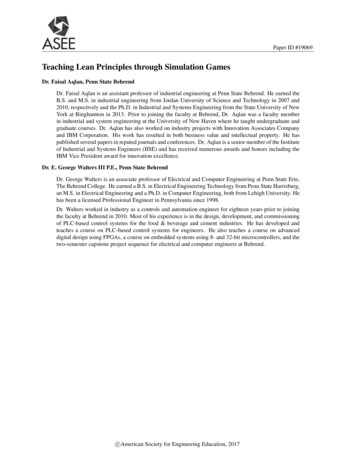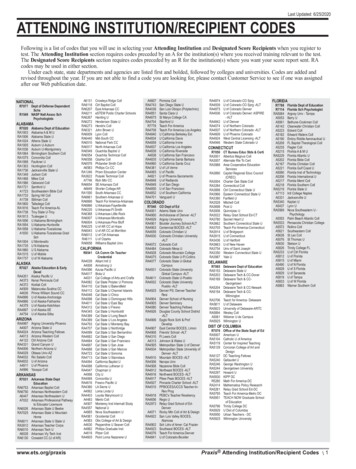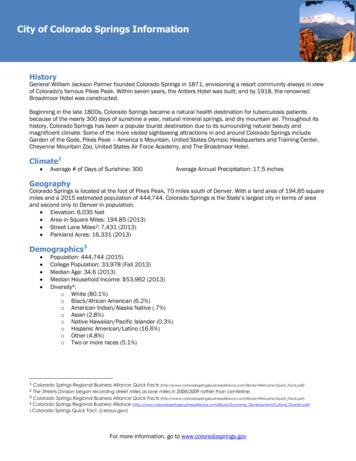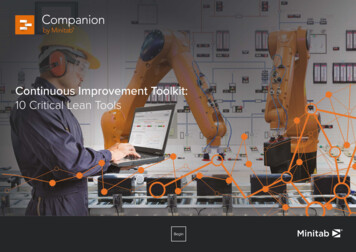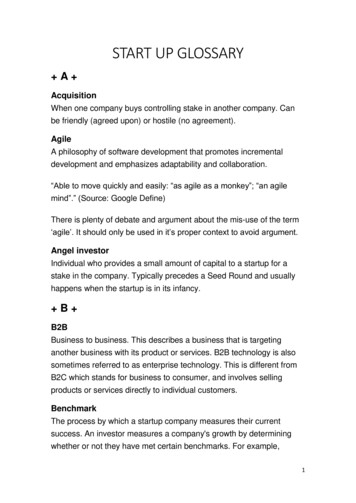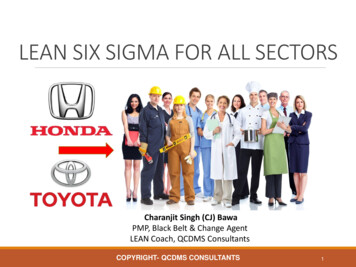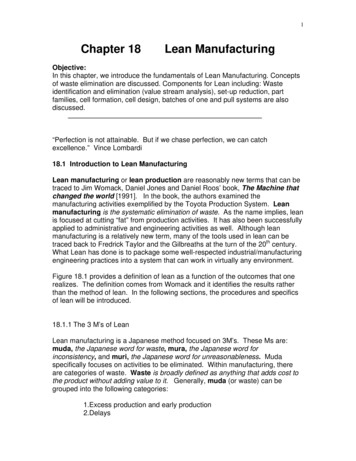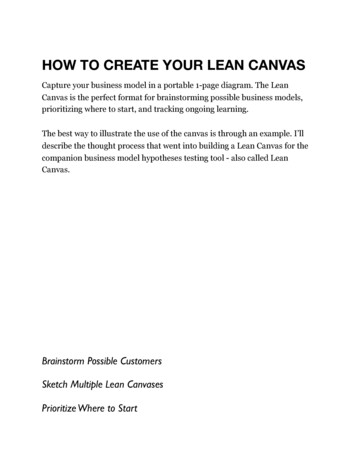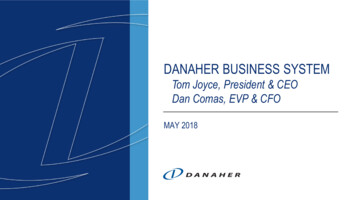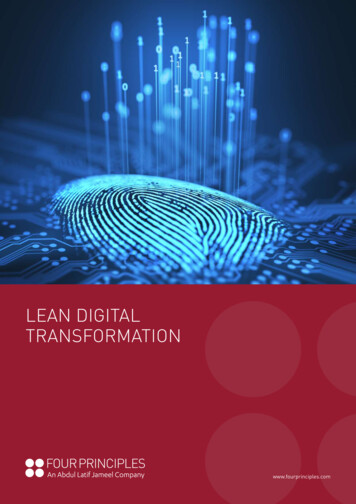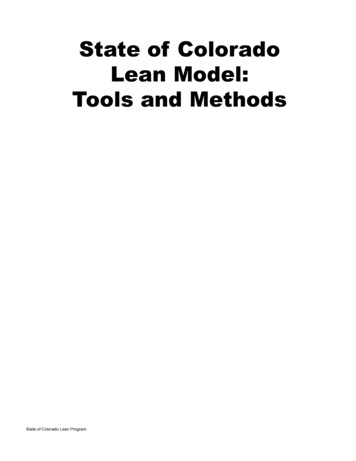
Transcription
State of ColoradoLean Model:Tools and MethodsState of Colorado Lean Program
Introduction to LeanState of Colorado Lean ModelState of Colorado Lean Program
Introduction to LeanOverviewLean is a systematic approach to continuous improvement, applying principles and tools to identify and eliminate waste. WhileLean was popularized in Japan, Taiichi Ohno, the father of the Toyota Production System, claimed he learned all he needed toknow from three distinctly American concepts: the Indy 500, Ford’s River Rouge Plant, and supermarket distribution. Toyotaconsolidated years of thinking into a systematic approach that is relevant not just to factories, but to business processes as well.The president of Toyota’s support for the program was driven by the idea of removing waste as a result of two important beliefsthat align to our goal of effective, efficient, and elegant state government: Waste is disrespectful of humanity because it wastes scarce resources; and Waste is disrespectful of individuals because it asks them to do work with no value.While the list of Lean tools is long, there are just five guiding principles:1. Define value – value can only be defined by the customer;2. Map value steams – documenting information and material flow that provide the product or service citizens require;3. Create continuous flow – internally having everything ready as needed for a symphony of service or production;4. Implement pull – provide a product or service only when it is needed and no earlier; and5. Strive for perfection – relentlessly chase perfection through error proofing and continuous evaluation and improvement.Throughout your training you will be introduced to a number of principles, methodologies, and tools. To help organize all thedifferent components of Lean and to assist you in taking the right action at the right time, the State of Colorado has developed itsown Lean Model. As you are introduced to each topic, you will also learn how to apply the information within context of thisframework.Before we dive into individual topics, please take time to review the model in greater detail.State of Colorado Lean ModelKey Information Lean is a systematic approach to continuous improvement that aims to make processes moreefficient, effective, and elegant by eliminating waste. The Lean methodology can be summarized into five key principles but is supported by numeroustools and techniques. The State of Colorado Lean model will help provide a framework for all Lean tools and methods.Additional ResourcesBook: Extreme Government Makeover by Ken MillerBook: Lean Thinking: Banish Waste and Create Wealth in Your Corporation by James P. Womack, Daniel T. JonesArticle: http://www.lean.org/WhatsLean/Principles.cfmState of Colorado Lean Program1 of 2
Introduction to Lean (cont’d)State of Colorado Lean ModelThis model will help you understand how Lean components relate and work together to form a continuous improvement cycle.1 - Learn ContinuouslyLean is comprised of a multitude of principles, methodologies, and tools. While you will be armed with the basic tools you need to getstarted, you will need to continue to refine and deepen your knowledge. Lean cultures are based on continuous improvement andyour development is no exception. Leaders in a Lean organization will be expected to continue their learning through self-guidedmaterials or additional course work.Operationalize LeanSponsors, champions, and Lean project leaders work together to operationalize Lean. Operationalizing Lean is not confined toproject completion; it also includes daily management and on-going process evaluation. Sponsors and champions will assist projectleaders as they execute projects by guiding the project approach, offering insight, and asking probing questions.This process is broken into (7) main phases to help compartmentalize the tools and methodologies, but some tools may span acrossphases. As you continually advance your Lean knowledge and experience, you will begin to see the ways you might leverage apractice in more than one area.2 - Identify andSelect Projects3 - Scope andApprove Projects Identify potentialvalue streams andservice areas thatcould benefit froma Lean approach Complete projectscoping, clarifyingopportunity,targeted outcomesand projectboundaries Prioritize theseopportunitiesbased on criteriaTopics Project Selection Gain leadershipapproval forscope, resources,and scheduleTopics Project Scoping SIPOC4 - EnvisionCustomerExperience5 - EvaluatePerformance Specify value inthe customer’seyes Clarify customerand strategicneeds Articulate theintended customerexperience toguide Lean teams’efforts EstablishperformancebaselineTopics Gaining CustomerPerspective andFeedback EnvisionCustomerExperience6 -CharacterizeIssues Identify andquantify defectsand errorsimpactingperformance Isolate rootcauses andprioritize problems Narrow focus tokey areas thatimpact processperformanceTopics Value Stream Map Lean ProcessMetrics Value Add v. NonValue Add 8 Wastes 5 GovernmentProcess PitfallsTopics Process FlowDiagram Check Sheet Histogram /Pareto Cause & Effect /Fishbone 5 Whys Spaghetti Chart7 -Solve Problems8 - Sustain Gains Solve problems asa group Change theprocess andworkplace toretain gains Implement newmethods forexecutingprocesses Enhanceefficiency throughworkplaceorganization andcooperationTopics 5S Kaizen A3 WorkloadBalancing Product FamilyMatrix Cellular Flow Kanban Establishmonitoring ofimprovedprocesses Engage all levelsin processownership andimprovementTopics VisualManagementTechniques Mistake Proofing Lean DailyManagement(QDIP) SustainmentChecklist9 - Actively Manage ChangeLean is founded on the idea of continuous improvement, so your organization and team will be improving processes frequently. Thischange will be beneficial, but it can be difficult as it requires adjusting to a new way of doing things. You will need to understand yourstakeholders, develop and execute a communication plan, conduct training, and prepare to manage feedback and resistance.SearchTerms /RelatedTopics 5 Principles of Lean Toyota OverviewState of Colorado Lean Program WasteState of Colorado Lean ModelToolsMethodologiesContinuous Improvement2 of 2
Roles and ResponsibilitiesOverviewA Lean organization requires people to function in several roles. We will focus here on three main roles: sponsors, Leanchampions (coaches), and Lean project leaders (LPLs).Sponsors are business leaders who are responsible for selecting and scoping projects, selecting teams, removing obstacles, andsustaining project results. Sponsors will guide LPLs on projects by understanding progress, addressing risks, and removingobstacles as needed.Lean champions are individuals who have a mastery of Lean tools and techniques. Champions coach, train, and mentor projectleaders and may lead high-value projects themselves.Lean project leaders will lead Lean project teams in addition to their regular duties. A team of process experts will help the LPLexecute each project. LPLs must accurately report project progress and elevate risks to the sponsor.State of Colorado Lean ModelRoles as They Relate to the Lean ModelWhere to BeginSponsors will need a detailed understanding of the EnvisionCustomer Experience material since they will be leadingvision sessions. Sponsors must be skilled in the philosophydiscussed in the Operationalize Lean module so they candirect LPLs and ensure sustainment of project improvements.Sponsors will also need to be well versed in the ActivelyManage Change module so they can effectively work andcommunicate with stakeholders and other people in theorganization. Once you understand how your role fits within the Leanprogram, work with your colleagues to begin the Leanprocess.Champions will master all components of the Lean model tothe extent that they will be able to teach and mentor all roleswithin a Lean organization. Embrace continual learning beyond the classroom byreading reference material and visiting the eLearning site. Engage with champions to test your understanding. Sponsors should identify key stakeholder groups andprepare for managing change in the organization. LPLs and sponsors should discuss opportunities, projectscoping, and progress.LPLs will focus their efforts mastering the OperationalizeLean tools and techniques. LPLs will also be involved inEnvisioning the Customer Experience and Actively ManageChange but will not be the main owner for these tasks.Key Information In a Lean organization, everyone has a meaningful role. Sponsors, Lean project leaders, and Lean champions must partner together and share knowledgeto realize gains from Lean. The level of understanding and use of each component in the Lean model will vary by role.Additional ResourceseLearning Module: ies (Note: terminology differences may exist)State of Colorado Lean Program1 of 2
Roles and Responsibilities ponsorBusinessleader whodrives Leanresults bydirectingprojects andowning theirsuccess Identifies and approves projects that link to business strategy Assists with culture change at the local level through communication and Lean managementprinciples Manages the people aspects of process changes on an ongoing basis Builds improvement infrastructure for sponsored projects Recognizes and defines projects and value stream visions Selects Lean project leaders and assigns projects to each Selects steering team and project team for each project Allocates team members to projects and removes roadblocks to project success Reviews project activity often with Lean project leaders Reports project activity to executive team Drives the implementation of the team solution Drives realization phase with finance representative assistanceChampion CoordinatesdepartmentLeandeployment Develops and continually improves Lean skillsAllocates internal resourcesMaintains department master planSpearheads communications and manages changeFacilitates deployment of Lean within an agency to support agency strategy, working in concert withsponsors and executive leaders on strategic project identificationTrains and mentors Lean project leaders to competency on the Lean methodologyCoaches Lean project leaders through Lean continuous improvement projectsMaintains touch with Lean culture within an agency; takes actions to improve acceptance andacceleration of LeanDevelops and implements sustainment plan in collaboration with executive leadersSupports sponsors and executive leaders with strategic project identification and scopingEmploys knowledge, tools and skills to create widespread commitment and manage the details of achange initiative, large or smallLeanProjectLeaderPractitionerof Leanmethodologywho leadLeanactivities Develops and continually improves Lean skillsLeads Lean project teams and projectsReports progress and identifies barriersCoordinates project change management activitiesIdentifies potential Lean projects and develops project scope for approvalDevelops and implements sustainment plans in collaboration with business leadersParcels and focuses Lean efforts according to an analysis of value add vs. non-value add work in aprocess, as revealed through the value stream mapTeamMemberParticipateson teams Provides process expertise to Lean teamsActively participates in projects, collecting data, evaluating solutions and tool applicationAssists sponsor(s) with the implementation and long-term sustainment of the solutionLearns and applies basic Lean training such as key principles and Lean methodologyLearns and applies basic tools under Lean project leader’s guidanceLean Program Organizational Structure A Lean Program Management Office (PMO) has been established within the Governor’s Office of State Planning and Budgetingthat supports the development and sustainment of the Lean Program across state departments. The Governor’s Budget and Efficiencies Committee provides guidance, strategic oversight, and makes program-level decisions. Each department will select Lean champions who will direct the roll-out of Lean within their department.SearchTerms /RelatedTopics Evaluate PerformanceSponsorsLean Project LeadersState of Colorado Lean Program Champions (Coaches)Program Management Office (PMO)State of Colorado Lean ModelOrganizational Structure2 of 2
2 – Identify and SelectProjectsState of Colorado Lean ModelState of Colorado Lean Program
Identify and Select ProjectsOverviewIdentifying and selecting the right project can be as important as how well a given project is executed. There are several effectivemethods of identifying potential projects. Five of the most popular sources include: conducting value stream analyses (VSAs),responding to customer feedback, furthering a strategic or operational plan, analyzing performance metrics, and responding toemployee suggestions. As Lean maturity increases, a natural evolution will be to identify projects linked to the organization’sstrategic or operational plan.Once a list of potential projects has been created, they must be evaluated and prioritized. A proven way to reach agreement onpriority is to select those projects with the greatest potential impact and which appear to be the easiest to implement (seeexample on the page after next). These high-potential project(s) can be evaluated against criteria and then sequenced by thereadiness of the given area where the project resides. (Note: The State of Colorado Lean Program Management Office (PMO)has defined several project selection criteria for evaluating candidate projects. The list is provided on the page after next.)This process lends objectivity to the effort of prioritizing projects, limiting the tendency for pet projects to be worked. Thisprocess also helps limit the number of projects being worked, ensuring that the requisite management support and resources areavailable.State of Colorado Lean ModelWhen To Use It In the LifecycleHow to Apply ItOnce projects have been identified, project prioritization mayoccur as a broader exercise and many projects may be putforward. Sponsors and Lean project leaders should worktogether to ensure that the potential project ideas are highimpact and low difficulty by completing the baselineassessment and identifying the significant issues. Develop a project suggestion list by considering the fivesources for improvement opportunities.In the case that the project idea does not achieve the intendedgoal, it should be abandoned. If a project is in fact a “just doit”, then avoid squandering project resources and “just do it!” Prioritize ideas by placing them in a 2x2 matrix: impact vs.ease of implementation. Clarify the ideas in the high impact / low difficulty quadrantof the chart to ensure common understanding. Evaluate high impact / low difficulty opportunities on adecision scorecard: Supports one or more of the Governor’s initiativesHigh impact to customer valueFinancial benefitDepartment or division priorityResources and project leader availableOther key priorities Select the project with the best alignment to the criteria.Key Information Sequence these projects and execute in order. High impact / low difficulty project ideas should be prioritized from a larger set of opportunities. Objective criteria should be used in the selection. Ensure the project also has executive leaders support, available resources, and project leadership.Additional ResourcesProcess Guide: Lean Project Prioritization (available from the State Lean PMO)Tool: Lean Project Prioritization Matrix (available from the State Lean PMO)State of Colorado Lean Program1 of 3
Identify and Select Projects (cont’d)Potential Sources of Project IdentificationA listing of potential Lean projects may be arrived at by utilizing at least these five sources:123Value SteamAnalysis (VSA)CustomerFeedbackAnalyze a valuestream that iscritical to rs criticalto qualitydemands; gathercustomerfeedback todetermine causesof dissatisfactionStrategic orOperationalPlanDetermine whichstrategic oroperationalimperatives couldbe furthered byapplying lyze trendsand determineshortfalls on keymeasures ofquality, delivery,inventory, andproductivity(QDIP)Requestemployee input onhow to betterserve customersand makeoperations moreefficient;encourage“outsight”Inputs to a Brainstorm of Potential Project IdeasMining these five sources (and others) ensures a wideranging group of project suggestions that will improve bothoperational efficiency and customer serviceNote: Not all suggestions will be worthwhile Lean projects. Conducting disciplined project scoping helpsseparate those ideas which will benefit from the rigor of a Lean project versus those suggestions that are “justdo its.” A steering committee will be formed only after the project sponsor and Lean project leader havevetted the opportunity.State of Colorado Lean Program2 of 3
Identify and Select Projects (cont’d)ExampleA four-step process can be used to facilitate a group of leaders to develop and evaluate the opportunitieswith the goal of settling on six to eight potential Lean projects.Lean PMO Project Selection Criteria Ease of implementation Process data is available Supports one or more of the Governor’s Inter-department opportunityinitiative(s) Department leadership support Size of the opportunity Resource availability Impacts external customer Department project leader is or will be identified Financial benefitEach of these must be in place to launch a project Process is understoodNote: In a decision scorecard tool, each criterion should receive an importance score of 1-5Guideline: Not all criteria can be “4s” and “5s”SearchTerms /RelatedTopics Evaluate PerformanceEnvision Customer ExperienceBrainstormingState of Colorado Lean Program Project PrioritizationCriteriaSteering TeamDecision Matrix3 of 3
3 – Scope and ApproveProjectsState of Colorado Lean ModelState of Colorado Lean Program
Scope and Approve ProjectsOverviewSetting the appropriate boundaries, or scope, of a project is critical for its eventual success. Clearly articulating what is in scopeand what is out of scope helps team members maintain their focus and guides their activities. It also allows for transparentprogress tracking. Setting the scope of a Lean project is synonymous with completing a scoping document, which defines morethan just the scope of the project.In the ‘Scope and Approve Projects’ module, the scoping document clearly states the problem to be solved, lists goals andmetrics to gauge success, identifies team members and other stakeholders, and lays out a high level plan for accomplishing theproject.Another useful tool in setting scope is a SIPOC diagram. SIPOC stands for Supplier-Input-Process-Output-Customer. Theindividual or team who completes the scoping document should also create this diagram (See SIPOC tool document).State of Colorado Lean ModelWhen To Use It In the LifecycleHow to Apply ItOnce a potential Lean project has been identified and selected asa priority, the Scope and Approve Projects module can begin. Ascope document can be prepared by the project sponsor and Leanproject leader. Start by clearly stating the problem the team will address tofocus their improvement activities. This problem should bestated as an opportunity.Setting the scope, along with the targeted outcomes and metrics tobe used, is helpful in clarifying the nature of the project as well ascommunicating to other stakeholders. This process may requireadditional investigation using tools in the Characterize Issuesmodule to clarify the opportunities to be tackled by the project.Based on the scope, a steering committee and the core teammembers are identified.Note: For initial projects in a value stream, the vision for the valuestream is developed as an early task in the project. In thesesituations, the scope of the project may be refined as an outcomeof the visioning activity. Draw a simple diagram of the process which encompassesthe problem. Set the boundaries of the process so that the team hasenough latitude to cover the most likely causes of theproblem, yet can also make an impact and finish in areasonable amount of time. Examine customers of the process, outputs, inputs andsuppliers (in that order) from the SIPOC to fully understandthe scope. State which parts of the process, organization, etc. are outof scope to improve clarity.Key Information Scoping helps the team maintain their focus, guide their activities, and track progress. The scoping document must be approved for the project to start. Diagramming the process helps delineate what is in scope and what is out of scope.Additional ResourcesTemplate: Project Scoping (available from the Lean PMO)State of Colorado Lean Program1 of 2
Scope and Approve Projects (cont’d)ExampleScoping Document rojectKickoffSearchTerms /RelatedTopics Characterize IssuesVisioningProject CharterState of Colorado Lean ProgramIncludeanActionVerb(Whatwewanttodo) mberofdaysfornewemployeeonboarding” g? Whendidthisproblemstart?Howlonghasitbeengoingon? Wheredoesitoccur? Howmuch,orwhatistheextentormagnitudeoftheproblem? ofdaysby50%” oject.Theday- ‐to- tedandapproved?TypicalStepsInclude: Gainapprovaltoscopestatement(PMO/Sponsor) Developmacro- ‐map(SIPOC)withLeanprojectleader Selectteammembers(Steering,Core,Extended) Confirmprojecttimeline k0- ‐Week2Whenwilltheprojectkick- illed.TypicalStepsInclude: Holdprocessvisionsession Conductteamtraining SIPOCApprovalKick-Off2 of 2
SIPOCOverviewA SIPOC is a high level process map that provides context for a Lean process improvement project. SIPOC is an acronym forSupplier-Input-Process-Output-Customer and is useful for defining the scope of a project. The individual or team who completesthe scoping document should also create this diagram.By completing the SIPOC prior to beginning a project, the team prepares for the project by collecting examples of input andoutput reports, gathering forms used in the process, etc. Most of the initial project work revolves around understanding thecurrent state process. The SIPOC is a key tool to help the team understand and communicate the current state and the boundsof a given process as well as who might be critical to engage as the project develops.State of Colorado Lean ModelWhen To Use It In the LifecycleHow to Apply ItThe SIPOC should be prepared in concert with the scopingdocument. Diagramming the process will be useful for definingproject scopes and identifying customers, suppliers and projectstakeholders. It will also aid in selecting the steering group andcore team. The order in which you complete the SIPOC can beremembered using the phrase “Please Come Out InSeptember.” Thus, the order is process, customers,outputs, inputs, and suppliers.The SIPOC will be reviewed in the vision session by the steeringteam and again by the core team as they prepare for the project.The SIPOC is also the starting point for a Value Stream Map thatwill normally be developed to understand the current state processduring the Evaluate Performance project stage.Key Information Identify the high level process steps that the team canagree upon (typically four to seven steps). This establishesthe boundaries of the process. Populate the customer, output, input, and suppliercomponents for each input. Identify output, process, and input metrics that measure theprocess related to customer expectations and performancerequirements. SIPOC documents Supplier-Input-Process-Output-Customer flow for a given process orvalue stream. A SIPOC is useful in setting the scope of the project and should be completed with thescoping document. A SIPOC identifies the project scope boundaries and aids in identifying key processstakeholders and participants.Additional ResourcesExample and Templates: is/sipoc-diagram/Job Aid: Project Scoping (available from the Lean Program PMO)State of Colorado Lean Program1 of 2
SIPOC (cont’d)ExampleSearchTerms /RelatedTopics ScopingProcess Flow DiagramSuppliersState of Colorado Lean Program InputsProcessOutputsCustomersValue Stream Mapping2 of 2
4 - Envision CustomerExperienceState of Colorado Lean ModelState of Colorado Lean Program
Envision Customer ExperienceOverviewVisions have power when they change the decisions, choices, and actions of all of the people in an organization, not just the fewtop executives. Fundamentally, visions provide a proof of correctness for individual and group choices (i.e., "I know this choiceis good because it supports the vision”). Simply, a vision is a way to encapsulate what it means to be part of a specificcommunity: its aspirations, values, roles, and goals.One of the most important principles of Lean is that value is defined by the customer. Keeping this in mind, each Lean projectteam should be guided by envisioning the customer experience defined by improved value to the customer. This isaccomplished by having the steering committee for each project team create (or affirm) a vision statement for the value streamthe team is improving.The Lean visioning exercise comprises a method for ensuring that: The customer’s perception of value is clarified; There is a common vision of the customer experience along the value stream; and Lean teams’ efforts are aligned with the customer’s experience.State of Colorado Lean ModelWhen To Use It In the LifecycleHow to Apply ItTo execute the Envision Customer Experience module, it isrecommended to have a single vision for a value stream andits component processes, which means that a single visioncould be useful across several Lean improvement events orprojects. Prepare the steering committee by soliciting perspectiveson their vision of the customer experience.While Lean is first being deployed, the creation of the valuestream vision will most likely follow the scoping of a project.The steering committee is responsible for envisioning thecustomer experience. The scope of the project may be refinedas an outcome of the visioning exercise.Subsequent projects improving a value stream will simplyconfirm the vision. The vision can evolve over time, but shouldremain static during the analysis to enable the team to do theirwork. Communicating the value stream vision should beconsidered a part of the project. Solicit Outsight: Develop an example of how an idea from one contextwas used in a different situation Interview subject matter experts Research emerging trends Mine benchmarking data if applicable Develop a best practice listing that is relevant for the valuestream being considered. In the visioning session, brainstorm vision elements suchas customer experience attributes and performance goals. Transform elements into a customer experience visionstatement.Key Information A vision statement articulates how employees work together to create customer value via thevalue stream. There should be a common vision of the customer experience along the value stream. A single vision will apply to all Lean improvement events associated with that value stream.Additional ResourcesProcess Guide: “State of Colorado Lean Vision Cookbook” (available from the Lean Program Management Office)State of Colorado Lean Program1 of 2
Envision Customer Experience (cont’d)Process (excerpted from the Lean Vision Cookbook)Example Value Stream Vision from the Department of Local Affairs Housing ChoiceVoucher ProjectOur vision is to create a Housing Choice Voucher delivery system that is easily accessible andencourages participation of stakeholders. Through our utilization of technology, this system aims toempower employees and contractors to complete essential tasks in a concise and efficient manner.Further, by simplifying and streamlining our processes and our dedication to ongoing knowledgemanagement, we aim to eliminate barriers, redundancy, and waste while maintaining a high standardof quality and accountability.SearchTerms /RelatedTopics Envision Customer ExperienceCustomer ExperienceProject ScopingState of Colorado Lean Program Vision SessionCookbookBrainstorm2 of 2
Gaining Customer
Lean champions are individuals who have a mastery of Lean tools and techniques. Champions coach, train, and mentor project leaders and may lead high-value projects themselves. Lean project leaders will lead Lean project teams in addition to their regular duties. A team o
